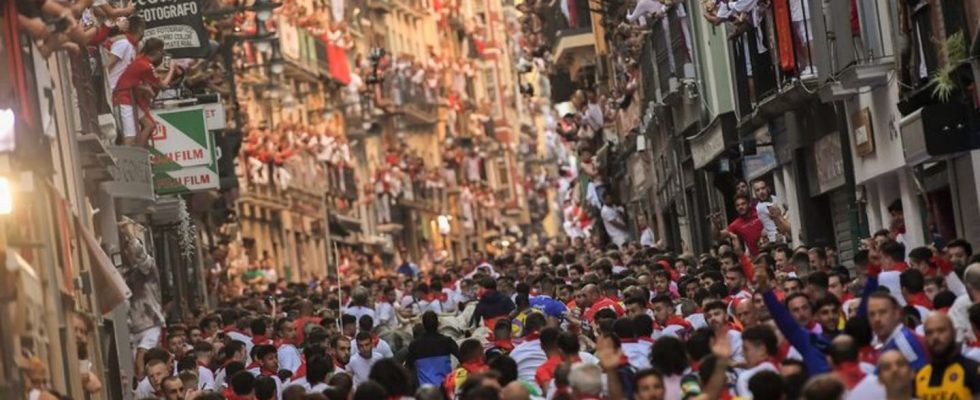regional customs
Bull hunting in Spain: Archaic tradition with a death kick
Full streets: Several people were injured in the second bull hunt during this year’s “Sanfermines” festival on Saturday morning in Pamplona in northern Spain. photo
© Alvaro Barrientos/AP
The “San Fermines” festival is famous and controversial. Battle pulls are propelled through the narrow streets of Pamplona. Young men in particular take part in the test of courage. Now there are injuries again.
Patxi Ibáñez got off lightly with a sprained finger and a bump on his knee. In the first The 50-year-old fell to the ground during the bull hunt at this year’s “Sanfermines” festival in Pamplona, northern Spain. He was lucky, as were five other injured people: none of the bulls, which weighed up to 600 kilograms, stepped on him or even speared him with their long, pointed horns.
The second hunt on Saturday also went relatively lightly, several runners came to the hospital with bruises, one with a ratchet on his arm – probably from a horn – as reported by the state TV broadcaster RTVE. But death always joins in when thousands of mostly young men herd six fighting bulls to the local bullring. There have been 16 fatalities since 1924, the last in 2009. Every year dozens of runners are injured, some seriously.
But for the participants who try to touch the bulls by the horns or slap them on the muscular body during the wild hunt through the streets, it is one big test of courage. In fact, you might have to be a bit cocky to run up close and personal with aggressive bulls through narrow streets.
A collective adrenaline rush
The runners, typically dressed all in white with their red neckerchiefs, are cheered on by tens of thousands of spectators, who are often tipsy from red wine and sangria. A collective adrenaline rush, so to speak, an escape from everyday life with a fully comprehensive mentality and the traditional image of men in transition.
State television RTVE and other broadcasters broadcast the first bull hunt live on Friday morning. There are also special programs, some of which last several hours. The details of each run, of which there will be eight in all through next Friday, are discussed at length, much like football matches. Which bull was particularly dangerous on which corner of the house, which runner got into trouble where, skilfully got to safety at the last moment – or was just overrun by a bull.
At each hunt, six bulls from a breeding farm are driven by tame oxen to the bullring, where in the evening they have the last big performance of their short lives. Each bull has a name, its fighting weight is highlighted, its courage and aggressiveness is acknowledged, and the breeding farm it comes from is commended. Even the quality of the lead oxen is discussed at length. If they are too slow, the chase will cause dangerous traffic jams in the narrow streets; if they are too fast, the spectacle will be too short and boring. Or a bull loses touch and attacks those around it. One of the runs rarely lasts longer than three minutes.
The festival in honor of the city saint San Fermín has been celebrated since 1591. The US author Ernest Hemingway wrote about this in his novel “Fiesta” (1926), which still attracts many tourists from North America to this day. According to a report by the Europa Press news agency, three of the lightly injured in the first run were US citizens. In 2020 and 2021 the celebrations were canceled due to the corona pandemic, but everything has been back to normal since last year. This year, for the first time after Corona, many tourists came from Asia, tour operator Mikel Ollo reports to the online medium “OKdiario”. For the city, the festival means an estimated income of up to 100 million euros.
Animal rights activists protest
But not everyone shares the enthusiasm. Animal rights activists have protested against the bull hunt for years, but in vain. They criticize that the hunt for the bulls is a single panic flight through crowds of people that are completely unfamiliar to them, which exposes them to enormous stress. And all 48 bulls would then be tortured in the bullfight in the evening and then killed. Activists always demonstrate against hate on the last day before the festival. This year, they swathed themselves in blood-red robes from head to toe and held up signs in multiple languages that read “Pamplona: Violence and Death to Cops.”
But the outrage does not visibly detract from the spectacle and the enthusiasm of the runners and visitors. Many runners have been there for a long time. So did Patxi Ibáñez, who fell during the first run. “I’ve been participating for many years, and today was just a small scare,” the newspaper “Noticias de Navarra” quoted him as saying. He definitely doesn’t want to be deterred. “I fell, but I’ll run again on Saturday,” he said as he left the hospital.

